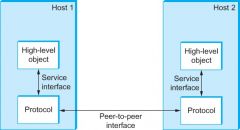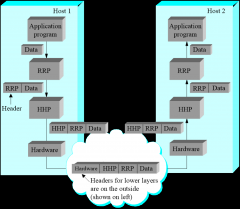![]()
![]()
![]()
Use LEFT and RIGHT arrow keys to navigate between flashcards;
Use UP and DOWN arrow keys to flip the card;
H to show hint;
A reads text to speech;
52 Cards in this Set
- Front
- Back
|
OSI Network Model Layers |
|
|
|
TCP/IP Network Model Layers |
|
|
|
OSI Mnemonic |
"All People Seem To Need Data Processing” |
|
|
Data Communication Protocol |
A set of rules governing and standardizing communication between computers. |
|
|
Protocol Specification |
Defines how a particular layer operates |
|
|
Protocol Implementation |
The actual system (hardware or software) that implements a protocol specification |
|
|
Service Interface |
A set of definitions that define how a protocol layer obtains services from the layer below. |
|
|
Service Interface Definitions |
send (data buffer, length, destination addr) |
|
|
Peer-to-Peer Interface |
|
|
|
Data Definition Example |

|
|
|
Service-Peer Interface Relation |

|
|
|
RRP |
Request/Reply Protocol |
|
|
HHP |
Host-to-Host Protocol |
|
|
MSP |
Message Stream Protocol |
|
|
Demultiplexing Key |
A standardized code in a header (at any layer) that tells the protocol layer reading that header which upper layer to pass the contents of its message to. |
|
|
Second Principle of Network Design |
Data originating in a given layer, along with that layer's header, is viewed as "data" by the protocol below. This process is called encapsulation. |
|
|
Encapsulation Diagram |

|
|
|
Orgs involved with OSI Standards |
ISO
|
|
|
Orgs involved with TCP/IP Model |
IETF
|
|
|
Application Layer (TCP/IP) |
Web, Email, Gaming, Video data |
|
|
Transport Layer (TCP/IP) |
|
|
|
Internet Layer (TCP/IP) |
|
|
|
Network Interface Layer (TCP/IP) |
|
|
|
Application Layer (OSI) |
|
|
|
Presentation Layer (OSI) |
|
|
|
Session Layer (OSI) |
|
|
|
Transport Layer (OSI) |
|
|
|
Network Layer (OSI) |
|
|
|
Data Link Layer (OSI) |
|
|
|
Physical Layer (OSI) |
Hardware that transfers signals across a medium. |
|
|
Internet Model Standards Dev Process |
|
|
|
Bandwidth |
|
|
|
millisecond |
ms, 0.001 or 10^-3 WAN |
|
|
microsecond |
us, 0.000001 or 10^-6 LAN |
|
|
nanosecond |
ns, 0.000000001or 10^-9 Processing in a computer |
|
|
picosecond |
ps, 0.000000000001 or 10^-12 |
|
|
Time to transmit 1 bit |
1 data rate |
|
|
Serial |
Bits sent through a single line one-by-one |
|
|
Parallel |
|
|
|
Networks typically use ____________ communication systems |
Serial |
|
|
Bits transmitted at a particular bandwidth have __________________________. |
a particular width per bit. |
|
|
Factors that affect frame transmission time |
Smaller frame -> Slower Data Rate Larger frame -> Faster Data Rate |
|
|
Latency |
|
|
|
Latency is affected by __________ |
|
|
|
RTT |
|
|
|
If there's a slow network, we ask _______________________? |
|
|
|
Total Latency Formula |
Total Latency = Propagation Time + Transmission Time + Queuing Time |
|
|
Transmission Time |
Time to send data "out the door" Message Size Data Rate |
|
|
Propagation Time |
Time to travel across the medium on a single link. Distance Speed of Medium |
|
|
Queuing Delay |
Delay caused by the time a packet/frame takes for processing (or waiting to be processed) in computers, switches, routers, and servers Amount of competing traffic Processing power of nodes |
|
|
Delay x Bandwidth Product |
|
|
|
For this class, we use calculations of __________ instead of ____________ to measure data size. |
Powers of Ten (1 KB = 10^3) instead of Powers of Two (1 KiB = 2^10) |

